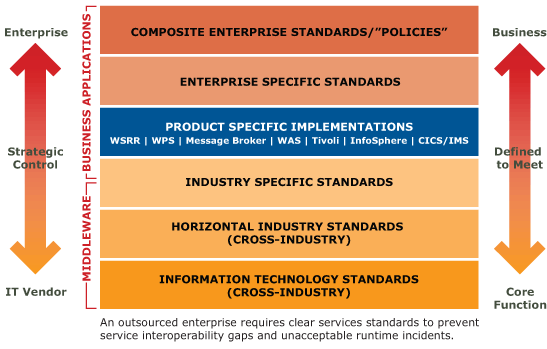Enterprise Architecture
Enterprise architecture is often dismissed as presentations made by super-geeks that no one understands (or needs to pay attention to). However, just as architectural blueprints are essential to build a house, enterprise architecture is a set of essential blueprints for realizing business strategy through IT, not just a bunch of pretty pictures drawn by a high-priced consultant.
The Open Group defines architecture framework as a "formal description of a system, or a detailed plan of the system at component level to guide its implementation…the structure of components, their interrelationships, and the principles and guidelines governing their design and evolution over time."
As SOA matures as the de facto architectural style and almost everyone's top-level architectural slides all look the same, it becomes even more important to explicitly drive from business requirements. Without an enterprise architecture that clearly links to the business strategy, it is virtually impossible to insure that IT systems and solutions will be financially and functionally effective in order to enable tactical and strategic execution. The enterprise architecture must provide the context and linkages to define the key parameters for managing IT investments, systems, technologies and processes to support changing business needs.
Key business components of the architecture include:
- defining the strategic business drivers and processes that enable execution of the business strategy,
- linking these enablers to corporate financials and investment decisions, and
- determining key decision-makers.
- creating application architectures,
- applying technology standards, and
- determining relationships of the technical components to each other.
At this point, with the deployment architectural and design patterns well defined for the technical components of most commercial IT systems, the enterprise architecture must specifically show how the technical components provide functional support for the critical business functions of the company. As most companies are moving to the SOA deployment architecture and building SOA-specific deployment infrastructures, the Enterprise Architect must clearly define how the common SOA patterns (e.g. ESB, service container, declarative policies, etc.) and standards (e.g. secure interaction for non public data with external entities) will be implemented to maximize business value as well as apply governance across the entire architectural stack.
Context for Setting Enterprise Standards and "Policies"

- define the business-specific technology standards (recommended or required) to be adopted with the roadmap for implementation and rationalized across each layer of the architecture,
- create a current list of products that are deemed to match those standards,
- define the building blocks for implementation by the overall Enterprise Reference Architecture.
- Clearly link to IT Governance in general, as well as Service Provider and Service Consumer governance via Registries and Repositories while defining the role of Services Policies for NFR and SLA specification and enforcement.
- Consider the architectural requirements of Information as a Service, describing the company's logical and physical data assets and associated data management tools with special focus on sensitive information that must be protected, controlled or selectively exposed
- by regulatory requirement (e.g. non-public health or financial data)
- as of proprietary importance to the business (customer lists, pricing guidelines, etc.)
- as value producing Information Services
Often overlooked in the creation of lower-level technology components architecture is how the critical IT support processes (for example, defined by ITIL) will actually implement the virtualization, governance, testing, provisioning, deployment, operations, support and delivery of IT mission-critical as well as business-value-critical services. This point becomes of crucial importance with the mix of virtualization across the platform, OS, middleware or application layers as well as the move towards private, public and mixed cloud computing.
Without these linkages, Enterprise Architecture will become an exercise in shelf-ware. But it need not be a massive undertaking that does not deliver near-term value. By applying an iterative approach, we can create an enterprise architecture in value-focused increments that address critical needs such as:
- Improved IT investment decision-making
- Re-use of existing IT applications and components
- Simplification of vendor evaluation and procurement as well as consolidation of third-party software and vendors into a rationalized deployment architecture minimizing expensive-to-support custom glueware
- Realizable enterprise SOA deployments, improved interoperability and operational management
- Greatly improved flexibility for business growth and change
- Faster time-to-market with improved profitability
A properly completed Enterprise Architecture provides the basis for IT management to influence business strategy in a language executive management can understand.
HHG consultants have delivered actionable enterprise architecture projects for multiple clients.
Our hands-on expertise integrating and implementing projects, as well as our financial and business process experience, inform our architecture work. An elegant reference architecture is useless if your company cannot implement it. A practical-to-implement enterprise architecture suitable to our clients' business needs enables our clients to better respond to rapid technological change while still keeping pace with ever more demanding business needs.
However, with the critical need for business agility, this is no longer enough. The Enterprise Architecture must provide actionable guidance for enterprise integration. HHG has completed many engagements where our consultants worked under EA's direction to ensure that the delivery organizations can implement the EA direction as operational infrastructure
HHG will provide implementation services. We also offer our customers implementation engagements to build and deploy any individually realizable portion of an architecture we recommend, developed by a third party or by HHG.
